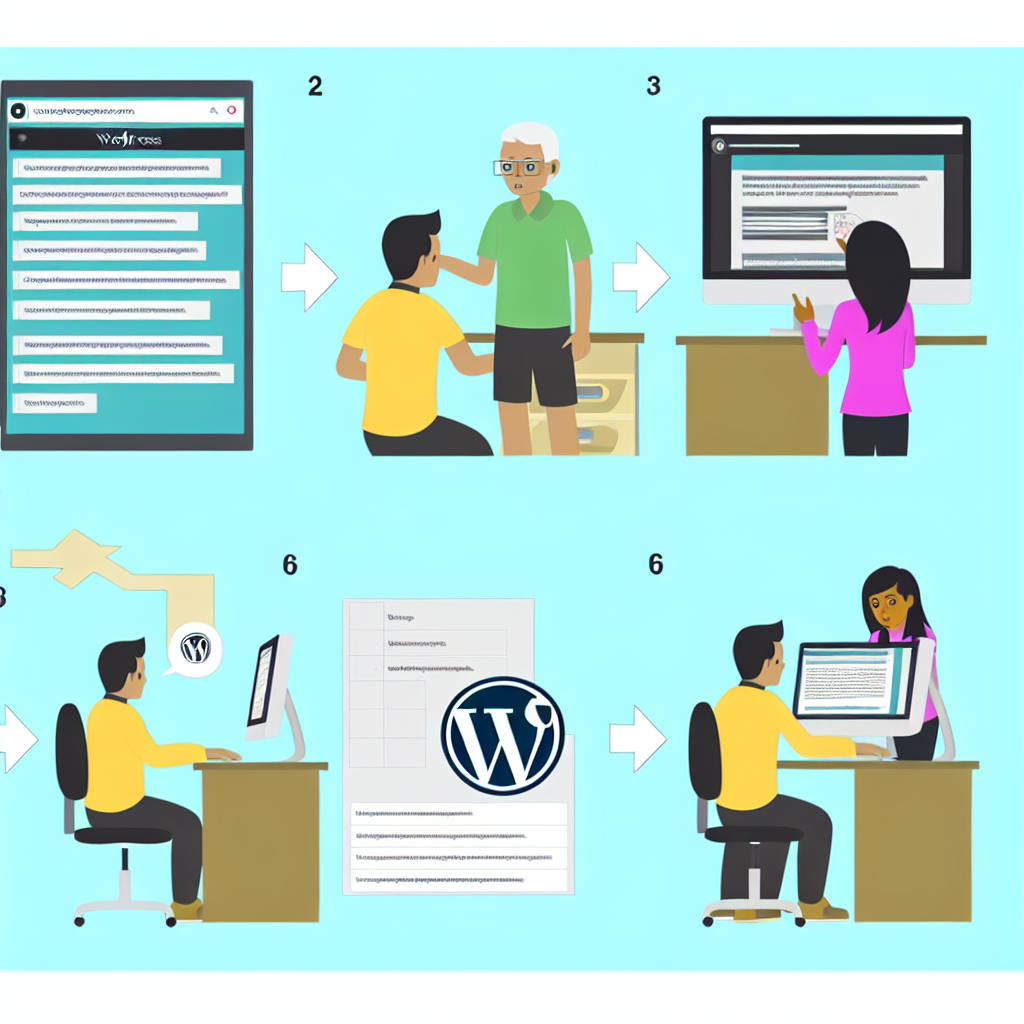### Step-by-Step WordPress Launch Guide: Start WordPress Website Without cPanel
Are you eager to bring your unique vision to life with a WordPress website but unsure where to start—especially without cPanel? You’re not alone. Many aspiring website owners face the challenge of launching their site without the user-friendly interface that cPanel provides. However, starting a WordPress website without cPanel is not only possible but can also be a straightforward process when broken down into manageable steps. In this article, we will walk you through the essentials of setting up your WordPress site without relying on cPanel, ensuring you have all the tools and knowledge necessary to create a professional online presence. Whether you’re a seasoned developer or a complete beginner, our comprehensive guide will equip you with the insights to navigate this process seamlessly. Let’s dive in and explore how you can start your WordPress website without cPanel today!
- Here are three possible headlines for sections of the article covering the topic of starting a WordPress website without cPanel:
- 1. **Understanding the Basics: What You Need to Start a WordPress Website Without cPanel**
Here are three possible headlines for sections of the article covering the topic of starting a WordPress website without cPanel:
## Step-by-Step WordPress Launch Guide: Start Your Website Without cPanel
Starting a WordPress website can seem daunting, especially if you’re accustomed to using cPanel. However, it is entirely possible to **start a WordPress website without cPanel**, and this guide will show you how. Whether you’re a beginner or a seasoned developer, this step-by-step approach will simplify the process and set you on the path to launching your site efficiently.
### Understanding the Basics of WordPress Hosting
Before diving into the technical details, it’s essential to understand what hosting options are available for creating your WordPress website without cPanel. Typically, web hosts use cPanel to manage server settings, databases, and files. However, there are alternative hosting solutions that provide user-friendly interfaces and tools to facilitate your WordPress installation.
#### Alternatives to cPanel Hosting
1. **Managed WordPress Hosting**: Services like WP Engine or Kinsta offer hassle-free WordPress installations, automatic updates, and enhanced security without the need for cPanel.
2. **Cloud Hosting**: Platforms like DigitalOcean and AWS allow you to deploy WordPress on cloud servers, giving you more control over your environment without relying on cPanel.
3. **Local Development**: Tools such as Local by Flywheel or XAMPP enable you to set up a WordPress environment on your local machine for testing before going live.
### Step-by-Step Guide to Start Your WordPress Website Without cPanel
#### Step 1: Choose Your Hosting Provider
– Research and select a hosting provider that suits your needs.
– Ensure that they offer a straightforward method for installing WordPress without cPanel.
#### Step 2: Domain Registration
– Choose a domain name that reflects your brand or niche.
– Register your domain through your hosting provider or a separate registrar.
#### Step 3: Install WordPress
– **Using Managed Hosting**: Most managed hosts provide a one-click installation feature. Log in to your account, navigate to the WordPress installation section, and follow the prompts.
– **Using Cloud Hosting**: If you’re using platforms like DigitalOcean, you can deploy a WordPress droplet with pre-configured settings. Follow the setup instructions provided by the hosting service.
#### Step 4: Configure Your Site
– After installation, log in to your WordPress dashboard.
– Choose a theme that aligns with your brand.
– Install essential plugins for SEO, security, and performance.
#### Step 5: Create Content
– Start creating posts and pages that resonate with your target audience.
– Use categories and tags to organize your content effectively.
### Best Practices for Managing Your WordPress Site Without cPanel
– **Regular Backups**: Use plugins like UpdraftPlus to schedule backups of your site.
– **Security Measures**: Implement security plugins such as Wordfence to protect your website.
– **Performance Optimization**: Utilize caching plugins and image optimization tools to enhance site speed.
### Conclusion: Take the Leap and Start Your WordPress Journey Today!
Now that you have a clear roadmap to **start a WordPress website without cPanel**, it’s time to take action. The process is straightforward, and with the right tools and guidance, you can launch a professional website that meets your goals. Don’t hesitate—embrace the world of WordPress and start creating today! If you want to learn more about optimizing your website for success, explore our additional resources and guides.
1. **Understanding the Basics: What You Need to Start a WordPress Website Without cPanel**
### Step-by-Step WordPress Launch Guide
Starting a WordPress website without cPanel may sound daunting, but with a clear roadmap, it can be a straightforward process. Whether you’re a seasoned web developer or a complete beginner, this guide will walk you through the essential steps to get your site up and running without the need for traditional hosting tools like cPanel.
#### Understanding the Basics: What You Need to Start a WordPress Website Without cPanel
Before diving into the technical aspects, it’s crucial to understand the fundamental components required to start your WordPress website without cPanel. Here’s what you need:
1. **Domain Name**: Your website’s address on the internet (e.g., www.example.com). You can purchase a domain from registrars like Namecheap or GoDaddy.
2. **Web Hosting**: Instead of using cPanel, you can opt for hosting providers that offer an alternative control panel or even a terminal-based management system. Options include:
– **DigitalOcean**
– **Vultr**
– **AWS (Amazon Web Services)**
3. **FTP Client**: A File Transfer Protocol (FTP) client allows you to upload files to your server. Popular options include:
– **FileZilla**
– **Cyberduck**
4. **WordPress Software**: The content management system (CMS) that you’ll install on your server. You can download the latest version from the [official WordPress.org website](https://wordpress.org/download/).
5. **Database**: You’ll need a MySQL or MariaDB database to store your website’s data. Most hosting providers allow you to create a database using their interface or via the command line.
6. **Basic Technical Skills**: Familiarity with the command line and basic coding concepts will be advantageous as you navigate through the setup process.
### Steps to Start Your WordPress Website Without cPanel
Starting your WordPress website without cPanel involves a few key steps. Here’s a streamlined process to guide you through:
1. **Purchase a Domain and Hosting**:
– Select a reliable hosting provider that does not rely on cPanel.
– Register your domain name.
2. **Connect Your Domain to Your Hosting**:
– Update your domain’s DNS settings to point to your hosting provider.
3. **Access Your Server**:
– Use SSH (Secure Shell) to connect to your server. This is usually done through a terminal application.
4. **Install WordPress**:
– Upload the WordPress files to your web server using an FTP client.
– Create a MySQL database and user. Note down the database name, username, and password.
– Run the WordPress installation script by navigating to your domain in a web browser.
5. **Configure Your Site**:
– Follow the on-screen instructions to complete the setup. Enter your database details when prompted.
6. **Choose a Theme and Customize**:
– Once installed, select a theme that suits your needs and customize it using the WordPress dashboard.
7. **Install Essential Plugins**:
– Enhance your site’s functionality with plugins. Some must-haves include:
– **Yoast SEO**: For optimizing your site for search engines.
– **Wordfence Security**: For protecting your site from malicious attacks.
– **WooCommerce**: If you plan to sell products online.
8. **Launch Your Website**:
– Before going live, test your site thoroughly and ensure all links work correctly.
### Conclusion
Launching a WordPress website without cPanel may seem challenging, but with the right tools and knowledge, it can be a seamless experience. By following this step-by-step guide, you will be well on your way to creating a successful online presence. Don’t hesitate to take the leap—start your WordPress website without cPanel today!
For more detailed support or to delve deeper into specific steps, feel free to reach out or explore additional resources. Your journey to a stunning WordPress website begins now!
### Step-by-Step WordPress Launch Guide: Start Your Website Without cPanel
Are you looking to **start a WordPress website without cPanel**? You’re not alone! Many website owners and developers are opting for alternatives to cPanel when launching their WordPress sites. This guide will walk you through the essential steps for setting up your WordPress website without the hassle of cPanel, allowing you to take control of your online presence with ease.
#### Why Consider Starting Without cPanel?
Starting a WordPress website without cPanel can offer several advantages:
– **Flexibility**: You can choose from various hosting options, including cloud-based platforms and managed WordPress hosting.
– **Cost-Effectiveness**: Some hosting providers offer competitive pricing without cPanel, potentially saving you money.
– **Enhanced Performance**: Non-cPanel solutions can be optimized specifically for WordPress, improving site speed and reliability.
#### Steps to Start Your WordPress Website Without cPanel
1. **Choose a Hosting Provider**
Select a hosting provider that allows you to install WordPress without using cPanel. Look for options like:
– Managed WordPress hosting (e.g., WP Engine, Kinsta)
– Cloud hosting (e.g., DigitalOcean, Linode)
– Self-managed VPS hosting
2. **Register Your Domain Name**
If you don’t have a domain yet, register one through your hosting provider or a domain registrar. Ensure it reflects your brand and is easy to remember.
3. **Install WordPress Manually**
After choosing your hosting provider, you’ll likely need to install WordPress manually. Here’s how:
– Download the latest WordPress package from the official site.
– Upload the files to your server using SFTP (e.g., FileZilla).
– Create a MySQL database and user through your hosting control panel or command line.
– Configure the `wp-config.php` file to connect WordPress to your database.
– Run the installation script by navigating to your domain in a web browser.
4. **Choose a Theme and Customize Your Site**
Once WordPress is installed, select a theme that suits your brand. Customize it to reflect your style using the WordPress Customizer.
5. **Install Essential Plugins**
Enhance your site’s functionality by installing essential plugins. Consider these must-haves:
– SEO plugins (e.g., Yoast SEO, All in One SEO)
– Security plugins (e.g., Wordfence, Sucuri)
– Performance plugins (e.g., WP Super Cache, WP Rocket)
6. **Create Key Pages**
Start by creating essential pages for your website, such as:
– Home
– About Us
– Contact
– Blog
7. **Launch Your Site**
Before going live, double-check your settings, ensure your site is mobile-friendly, and test all functionalities. Once you’re satisfied, it’s time to launch!
#### Conclusion: Take the First Step Today!
Starting a WordPress website without cPanel may seem daunting, but with this step-by-step guide, you can confidently navigate the process. Whether you choose managed hosting or a cloud solution, the flexibility and benefits of bypassing cPanel are well worth it.
Ready to **start your WordPress website without cPanel** today? Explore your hosting options and take charge of your online presence! If you have any questions or need further assistance, feel free to reach out for expert guidance. Your digital journey begins now!

